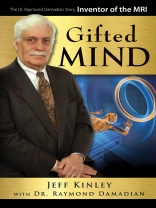One man’s search for truth on a personal journey of invention and faith!
Today, magnetic resonance imaging machines (MRIs) and similar technologies are saving lives in hospitals and clinics throughout the world. In 1969, this kind of technique was just an idea in the visionary mind of Dr. Raymond Damadian.
As a young boy, he watched his grandmother die painfully from breast cancer. Dr. Damadian would eventually decide on a career in medical research and pioneer this field of amazing research. Although in 1971 his concept of detecting tumors through magnetic resonance imaging was widely met with skepticism, he became the first researcher to do a full-body scan of a human being in 1977 in order to see if there was cancer present. His life has been an incredible journey of discovery helping you learn:
- How his concept for cancer detection was inspired and developed
- Why faith became an integral part of his work
- Why he is a strong supporter of the creativity and freedom found in patents.
From resourcefully creating his discoveries on a shoestring budget to a battle with the business behemoth known as G.E., learn how the exciting development of this technology led him to a self examination of his life and faith. What driving force is at the heart of what can arguably be called one of the greatest minds in the past 50 years and how does faith play a crucial role in his work?
Giới thiệu về tác giả
Dr. Raymond Damadian was born in New York and attended the University of Wisconsin–Madison, received an M.D. degree from Albert Einstein College of Medicine, internship and residency in internal medicine at State University of New York Health Science Center at Brooklyn, postdoctoral fellow work at the Washington School of Medicine, Harvard Medical School, before returning to State University of New York Health Science Center as a faculty member teaching biophysics to graduate students. He and his wife have been married for over 50 years, and have three children. He currently works at FONAR, a company he started that focuses on development and sales of more affordable MRI machines. His numerous awards include ones from the National Medal of Technology; induction into the National Inventor’s Hall of Fame; a Lemelson-MIT Lifetime Achievement Award, Honorary Fellow; and American Institute for Medical and Biological Engineering.












